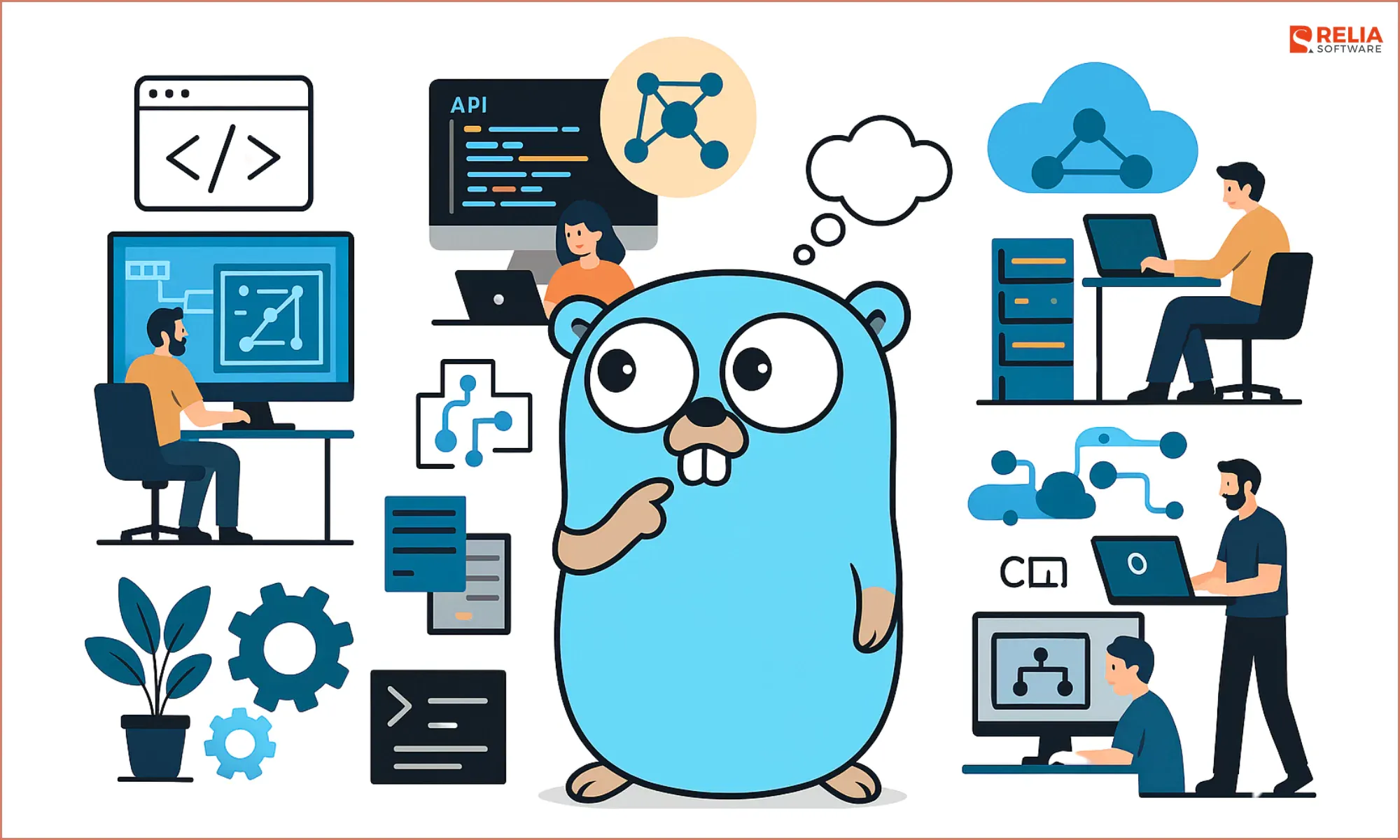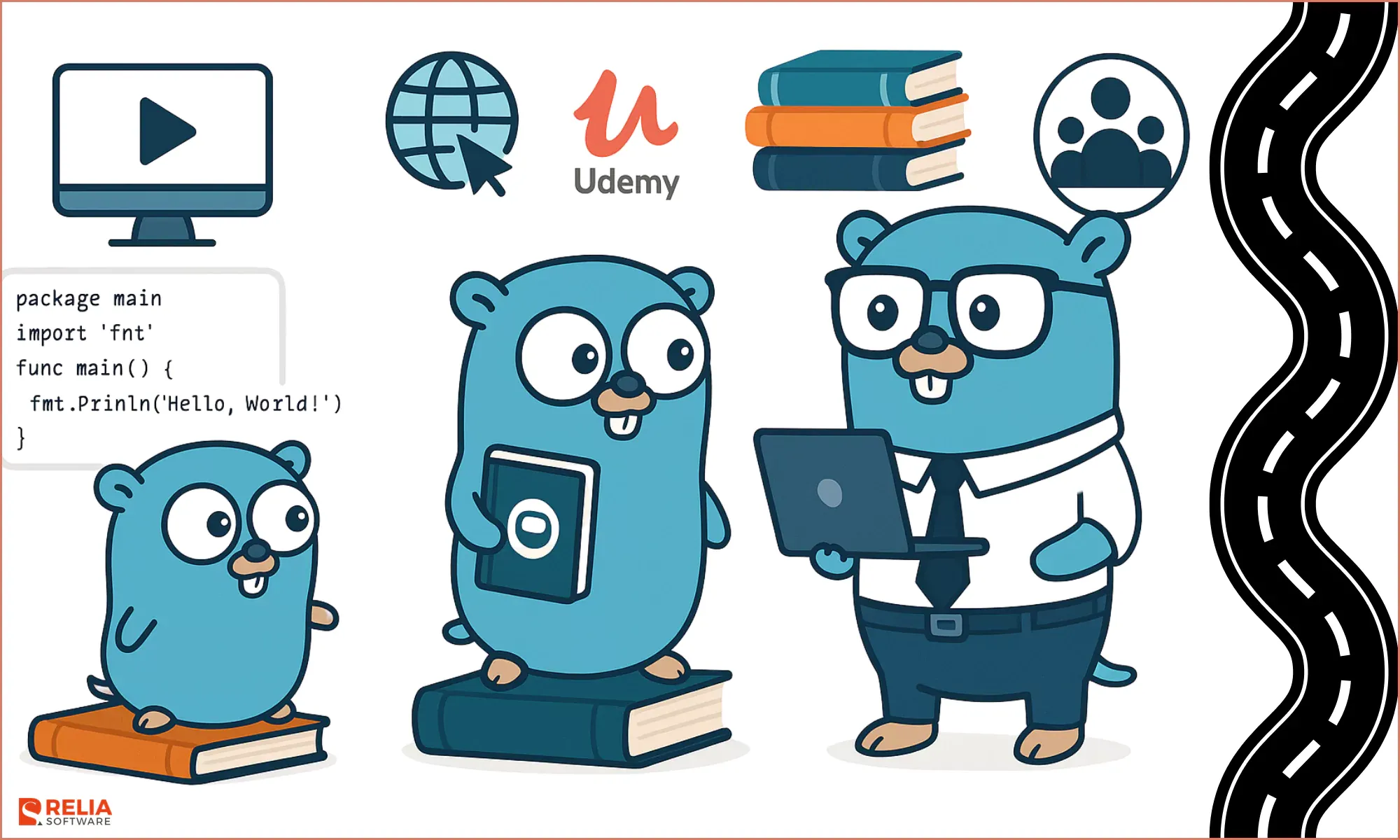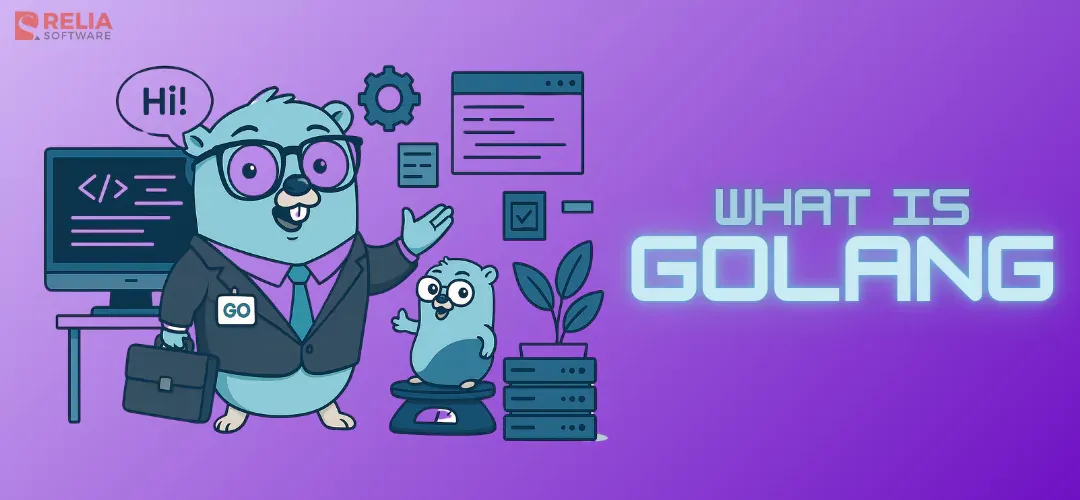Golang has become a popular programming language for many developers today. Big names like Google, Uber, and Netflix use it to build fast, reliable backends. Due to its speed and built-in support for concurrency, Go is great for modern web apps, network tools, and cloud-based systems. In this blog, we’ll see what makes Go such a powerful and popular choice.
>> Read more: Top 6 Best Golang Testing Frameworks
What is Golang?
Golang, or the Go programming language, is an open-source and statically typed language developed by Google in 2009. Their goal is to make this language easy to use, quick, and dependable. Developers may simply learn and use due its clear syntax and simple compilation.
Go's handling many tasks at once using something known as goroutines is among its strongest strengths. These lightweight threads make it great for building web apps that need to respond quickly to lots of users at the same time.
Go also takes care of memory management on its own, so developers don’t need to worry about handling memory manually, which helps avoid bugs and saves time.

Benefits and Drawbacks of Using Golang
Benefits
- Simplicity: Go with its simple syntax makes it easy to learn and maintain, especially compared to more complex languages.
- Speed: Golang code is compiled straight into machine code. This speeds execution without a virtual machine.
- Garbage Collection: Developers don't need to manually manage memory because it has its own automatic garbage collection. This prevents crashes and memory leaks.
- Concurrency: Go was designed with concurrency in mind. It uses goroutines and channels to handle many tasks at the same time, so Go is perfect for scalable apps.
- Built-in Functionality: Go has a strong set of built-in tools for tasks like networking, file I/O, JSON encoding/decoding, and more. So you often don’t need extra libraries.
- Statically Typed: Go is statically typed, meaning variable types are defined upfront. This helps catch errors before the code even runs, I mean, during compilation. So your code is much more reliable.
- Cross-Platform: You can run Golang code on various operating systems, including Windows, macOS, Linux, and more. It’s flexible and easy to deploy anywhere.
- Open-Source: The open-source approach lets the Go community help with ongoing development and contributions.
- Large Community: Go has a large and growing developer community which can provide lots of support, tutorials, and reusable code.
>> Read more:
- Mastering 6 Golang Concurrency Patterns
- A Complete Guide to Debugging Go Applications with Go Tracing
Drawbacks
- Young Language: Compared to established languages like Java or Python, Golang has a smaller ecosystem of libraries and tools.
- Error Handling: Handling errors in Go often requires writing more code. Some developers find the error messages a bit less helpful, which can make debugging harder.
- Limited Reflection: Reflection, a feature that allows inspecting code structure at runtime, is limited in Golang. This can impact certain functionalities that rely heavily on reflection in other languages.
- Steeper Learning Curve: If you’re used to traditional object-oriented programming (like in Java or C++), Go’s approach to structuring code may take some getting used to.
What is Golang Used for?
Golang is a flexible language that can be used to build all kinds of applications. Thanks to its speed, simplicity, and built-in support for handling many tasks at once, Go has become a top choice for developers in different areas. Here’s a closer look at where Go really shines:
Web Development
- Backend Services: Go is ideal for creating fast, dependable backends that can handle high traffic. Its goroutines allow multiple processes to run concurrently without slowing down. Go web frameworks like Gin or Echo can create web apps that include routing, middleware, and other features.
- APIs: Clean code style and strong performance of Go make it perfect for creating APIs that allow apps to talk to each other in a smooth and reliable way.
Network Programming
- Servers: Go is a strong pick for creating web servers (like Caddy) or network servers (like GoBGP). It handles network connections efficiently and can manage many users at once.
- Networking Tools: Developers frequently use Go to build tools for network monitoring, custom protocols, and diagnostics, particularly command-line tools.
Cloud Computing
- Microservices: Go is ideal for microservices meaning small services that each do one job but work together in the cloud. Its lightweight design and concurrency support make development faster and more scalable.
- Containerization: Go runs nicely within Docker containers and integrates well with platforms like as Kubernetes, making deployment and scaling easy.
DevOps Tools and Automation
- Continuous Integration and Continuous Delivery (CI/CD) Pipelines: Go's fast build time and simple scripting make it ideal for automating builds, tests, and deploys within DevOps workflows.
- System Administration Tools: Golang is a strong tool for building custom system administration systems that automate repetitive processes and manage infrastructure.
Other Applications
- Command-Line Interfaces (CLIs): Go helps create fast, simple tools you run from the terminal. You know, many popular CLI tools today are built in Go.
- Data Processing Pipelines: Golang efficiently handles data-intensive tasks due to its concurrency features and built-in functionalities for working with data streams.
- Scientific Computing: While Go is not as specialized as Python in this area, it still meets some scientific computing needs, particularly when speed is important.
This list comprises some of the most popular Golang use cases. However, its flexibility allows its usage in a variety of other applications.

When to Consider Alternatives for Golang?
Go is an nice language, but like any tool, it is not always the greatest fit for every situation. Depending on what you're building and your team's background, there may be better solutions. Here are a few scenarios where you might want to consider other languages:
- Need for a vast existing library ecosystem: For projects requiring a wide range of specialized libraries, mature languages like Python or Java might offer a broader selection.
- Deep Object-Oriented Programming (OOP) focus: Go doesn’t use classes in the traditional way. If your team is developing something with complex object-oriented patterns, Java or C++ languages feel more natural.
- Limited experience with non-OOP paradigms: Developers with a strict OOP background may need more time to transition to Golang's approach to data structures and procedures.
- Project requires extensive reflection capabilities: Golang's limited reflection features might restrict functionalities that rely heavily on runtime code inspection.
Here are some examples of projects where alternatives might be preferable:
- Developing complex scientific simulations with intricate object interactions.
- Building a large enterprise application with a strict OOP design requirement.
- Projects requiring a specific library that's not well-established in the Go ecosystem.
Ultimately, the best choice depends on your specific project requirements and team expertise.
Golang vs. Popular Languages: A Comparative Analysis
Although Go is a flexible language, how does it compare to other well-known programming languages? Let's see how Go stacks up against Python, Java, and C++ in practical applications.
Golang vs. Python
- Focus: Go is ideal for backends and performance-heavy apps because it is designed for speed and can manage multiple tasks at once. In contrast, Python is good at fast development speed, especially for scripting and data analysis with various tools including NumPy, Pandas, and Scikit-learn.
- Syntax: Golang has a clean and concise syntax, while Python is known for its readability and ease of use.
- Concurrency: Golang offers built-in features for concurrency with goroutines and channels. Python requires additional libraries for advanced concurrency management.
- Libraries: Python boasts a vast ecosystem of mature libraries like multiprocessing or asyncio for various domains, while Golang's library ecosystem is still growing.
Golang vs. Java
- Performance: Golang generally outperforms Java in terms of execution speed due to its compiled nature. However, Java offers mature performance optimization techniques like Just-In-Time (JIT) compilation.
- Object-Oriented Programming (OOP): Java is a strongly object-oriented language with well-defined classes and inheritance. Golang has a lighter take on OOP, focusing on structs and methods.
- Ecosystem: Java has a massive ecosystem of libraries, frameworks, and tools, while Golang's ecosystem is catching up but still smaller.
- Development Speed: Java can offer faster development due to its large ecosystem and established best practices.
Golang vs. C++
- Performance: Both languages offer excellent performance, but C++ requires more manual memory management for optimal results. Golang's garbage collection simplifies development.
- Complexity: C++ is a powerful but complex language with a steep learning curve. Golang prioritizes simplicity and readability.
- Applications: C++ is often used for system-level programming and performance-critical applications. Golang supports web development, network programming, and cloud-native development.
How to Choose the Right Language?
The optimal language for your project is determined by its individual requirements. Here is a simple guideline:
- For high-performance applications with concurrency needs, consider Golang.
- For rapid development, data science, or projects requiring a vast library ecosystem, Python might be a better fit.
- For large enterprise applications with a strong OOP foundation, Java could be preferable.
- If you need ultimate control over memory management and raw performance, C++ might be the choice.
Remember, these are only general comparisons. Each language has advantages and disadvantages, and reviewing documentation and tutorials for each option can help you gain a better understanding before making a selection.
>> Read more about the SOLID principle in Golang:
- Practical SOLID in Golang: Single Responsibility Principle
- Mastering the Open/Closed Principle in Golang
- Mastering the Liskov Substitution Principle in Golang
- Mastering The Interface Segregation Principle in Golang
- Detailed Code Examples of Dependency Inversion Principle in Go
- Best Practices For Dependency Inversion in Golang
How To Get Started with Golang?
Here's a roadmap to get you started on your Golang journey:
Official Resources
The official Go Programming Language website (https://go.dev/) is the ideal starting point. This extensive website from the Go team has everything you need to learn Golang, including installation guidelines, tutorials, and documentation.
Online Tutorials and Courses
The internet has plenty of resources for learning Golang. Here are some popular choices:
- Golang Tour: A great introduction to Golang syntax, concepts, and functionalities.
- Coursera - Learn Go Programming: A structured learning path with video lectures, quizzes, and hands-on projects.
- Udemy - The Complete Go (Golang) Bootcamp: A comprehensive curriculum covering Golang fundamentals, web development, and building real-world applications.
Book Recommendations
While online resources are fantastic, some learners prefer the depth and structure of books. Here are a few well-regarded options:
- The Go Programming Language by Alan A. A. Donovan and Brian Kernighan: This official book from the creators of Go is a must-have for serious learners.
- Head First Go by Dawn Griffiths and David Griffiths: This book takes a unique and visual approach to teaching Golang concepts, making it engaging for beginners.
A Simple Golang Example: Hello, World!
Let's write a classic "Hello, World!" program to get a taste of Golang syntax:
package main
import "fmt"
func main() {
fmt.Println("Hello, World!")
}
Explanation:
package main: This line declares the package name, which is "main" for standalone programs.import "fmt": This line imports the "fmt" package, which provides functionalities for formatted printing (like Println).func main() { ... }: This defines the main function, which is the program's entry point.fmt.Println("Hello, World!"): This line uses the Println function from the imported "fmt" package to print the message "Hello, World!" to the console.
Running the Program:
- Save the code as a file named
hello.go. - Open a terminal and navigate to the directory where you saved the file.
- Run the command
go run hello.go.
If everything is set up correctly, you should see "Hello, World!" printed on your console!

>> Read more about Golang coding:
- What Are New Features in Golang sync.Once?
- Understanding Golang Ordered Map with Code Examples
- Type Conversion in Golang
- Comprehensive Guide for Golang Unit Test with Code Examples
Conclusion
Golang's concise syntax, rapid performance, and built-in concurrency support have helped it gain popularity. It's a popular platform for developing online apps, network tools, and cloud services. That is why more and more businesses have high demands in hiring Golang developers.
Thinking about learning Go? Whether you're just starting out or already experienced, Go is a great language to grow with. It’s easy to pick up, fun to use, and powerful enough for real-world projects.
Thanks for reading—hope this guide helps you take your first (or next) step on your Golang journey!
>>> Follow and Contact Relia Software for more information!
- golang
- Web application Development

